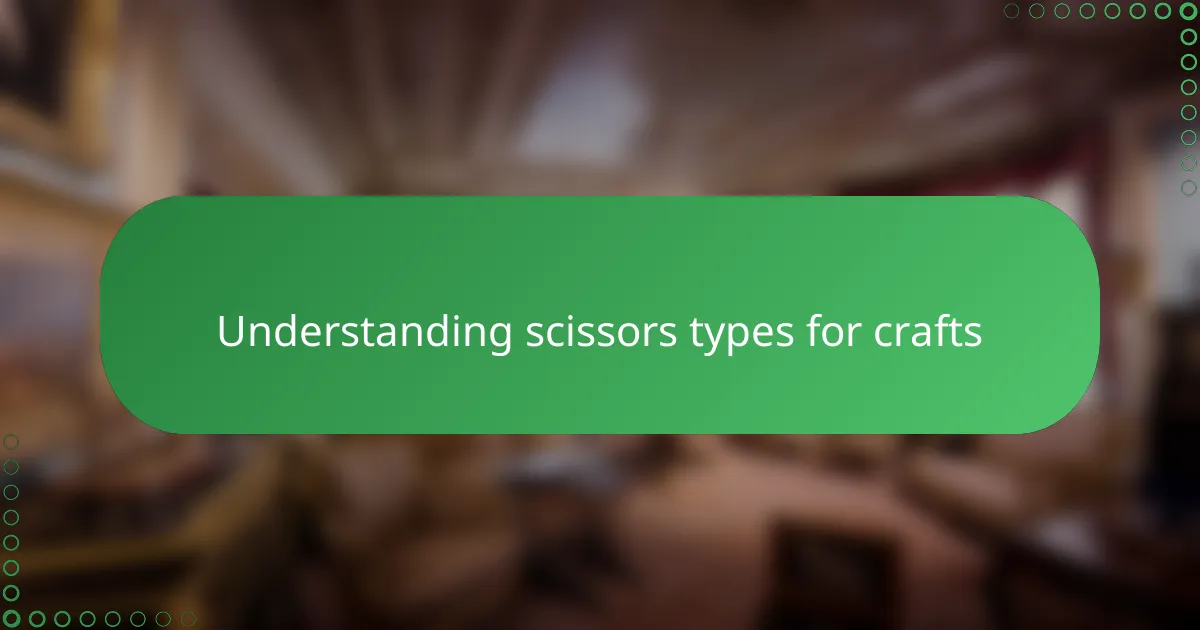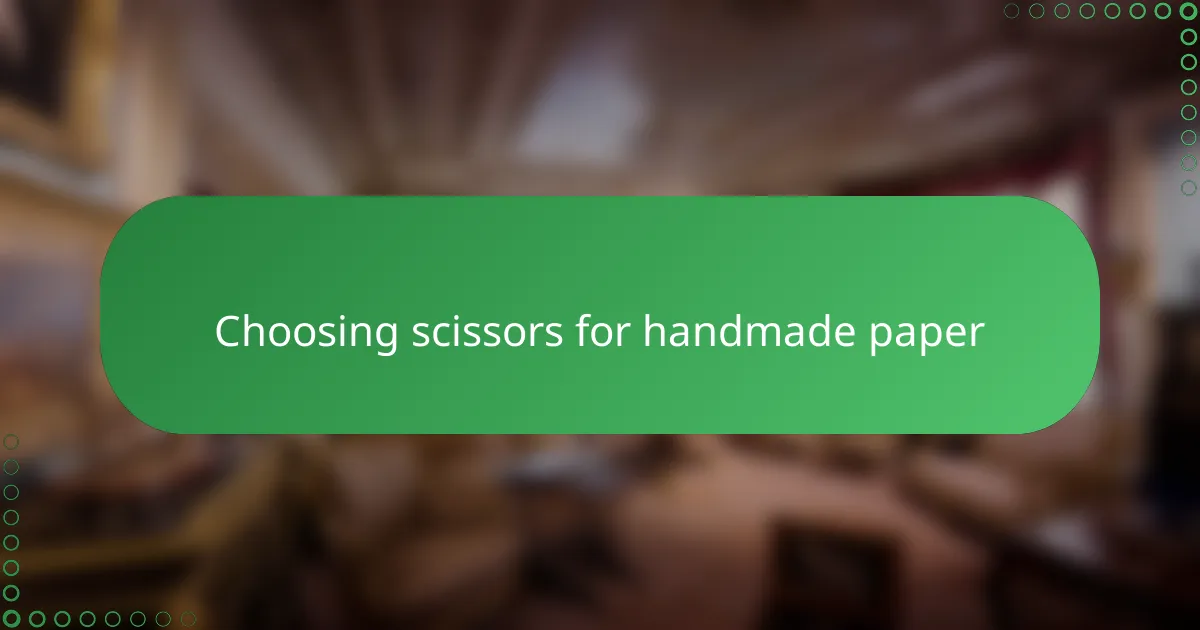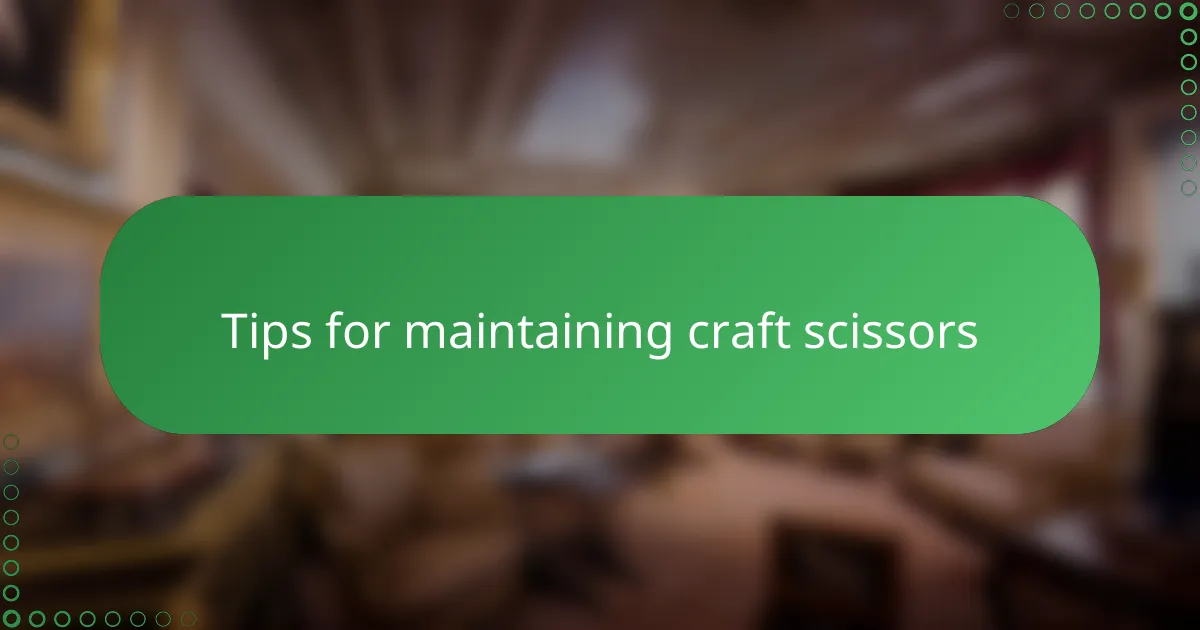Key takeaways
- Different types of scissors, such as precision and ergonomic models, greatly influence cutting quality and comfort during crafting.
- Key features to consider include blade sharpness, size and shape of the scissors, and comfortable grips to enhance the crafting experience.
- Testing scissors before purchasing—evaluating their movement, cutting ability, and comfort—ensures a satisfying crafting tool selection.
- Regular maintenance, such as cleaning and sharpening blades, is essential for keeping scissors in optimal working condition.

Understanding scissors types for crafts
When I first started crafting, I underestimated the impact that different scissors could have on my work. Did you know that not all scissors are created equal? For example, precision scissors with sharp, pointed blades help me cut intricate designs with ease, while heavier-duty scissors handle thicker materials like cardboard or fabric.
It surprised me how much smoother the cutting felt when I switched to ergonomic handles. Have you ever experienced hand fatigue halfway through a project? Choosing scissors with comfortable grips made a world of difference for me, allowing longer crafting sessions without pain or discomfort.
I always keep a pair of pinking shears on hand, too. Their zigzag edge not only adds a decorative touch but also helps prevent fraying on delicate paper or fabric. Understanding these subtle differences in scissor types has truly elevated my handmade paper crafts, making each cut more precise and enjoyable.

Essential scissors features for paper
One feature I never overlook is blade sharpness. I’ve learned the hard way that dull scissors tear paper instead of slicing it cleanly, which ruins my intricate designs. Have you ever felt that frustration when your scissors snag the paper? Keeping blades sharp means every cut feels effortless and precise.
Another essential aspect I’ve come to appreciate is the size and shape of the scissors. When working on detailed patterns, smaller scissors with pointed tips give me the control I need, almost like an extension of my fingers. On the other hand, bigger scissors can quickly handle straight cuts, saving time without sacrificing accuracy.
Finally, I can’t stress enough the importance of a comfortable grip. I found that scissors with cushioned, ergonomic handles reduce my hand strain immensely during long crafting sessions. It’s amazing how much more enjoyable and productive crafting becomes when your tools fit your hands just right, don’t you think?

Choosing scissors for handmade paper
Choosing scissors specifically for handmade paper has been a game-changer in my crafting journey. I quickly realized that scissors designed with thinner, sharper blades cut through delicate handmade paper more cleanly, avoiding those frustrating snags and tears that can ruin a project. Have you noticed how some scissors just glide through paper as if they were made for it? That’s exactly the kind of smooth precision I aim for.
What surprised me most is how the blade material influences the cutting experience. I prefer stainless steel blades because they stay sharper longer and resist rust—especially important when working with moisture-sensitive handmade paper. Have you ever struggled with rusty blades sticking to your paper? That nagging issue vanished once I switched to a better blade quality.
Comfort also plays a surprisingly big role in my choice. When I found scissors with soft, ergonomic handles tailored to my hand shape, I could craft for longer stretches without cramping or fatigue. It felt like having a trusted tool that worked with me, not against me. Don’t you think the right handles can make all the difference between a frustrating session and a creatively fulfilling one?

Comparing scissors brands and quality
Comparing scissors brands quickly taught me that price alone doesn’t guarantee quality. I once splurged on an expensive pair expecting perfection, only to find the blades misaligned and frustrating to use. Have you ever felt let down by a brand reputation not living up to its hype? That experience made me dig deeper into user reviews and hands-on testing before making a choice.
What really stands out to me when evaluating brands is blade durability and manufacturing precision. Some brands consistently deliver scissors that stay sharp through countless projects, which, in my opinion, is what truly matters for paper crafting. Don’t you find it comforting to rely on a brand that won’t dull after just a few uses?
Handle design is another factor where brands differ widely. I’ve noticed that some brands invest in ergonomic research while others stick to basic shapes, and that’s reflected in how my hands feel after hours of cutting. Have you ever finished a project with sore fingers just because your scissors weren’t thoughtfully designed? Choosing a brand that prioritizes comfort made my crafting sessions more enjoyable and productive.

How I test scissors before buying
When I’m testing scissors before I buy, the first thing I do is open and close them a few times to check the smoothness of the movement. If they feel stiff or make a grinding noise, I know they won’t cut gracefully through paper. Have you ever wrestled with scissors that fight you every time you try to snip? That struggle alone can ruin the joy of crafting.
Next, I grab a scrap piece of paper and make a few cuts, paying attention to how easily the blades slice through. A clean cut without any tearing or snagging tells me the blades are sharp and precise. I remember once choosing scissors without this test and ended up with uneven edges that completely frustrated me.
Finally, I hold the scissors as if I were mid-project to feel the grip and balance. If the handles dig into my fingers or feel awkward, I keep looking. For me, comfort is non-negotiable because long crafting sessions can lead to hand cramps otherwise. Don’t you think the right fit can transform a tiring task into a relaxing one?

Tips for maintaining craft scissors
Keeping craft scissors in top shape has made a huge difference in my projects. I make it a habit to wipe the blades clean after each use because even tiny bits of paper residue can dull the edges faster than you’d expect. Have you ever tried cutting and felt the scissors snag? That often means it’s time for a quick clean-up.
Sharpening is another key step I never skip. I once ignored my scissors getting dull, thinking they were just “fine enough,” and ended up ruining an entire delicate paper design. Investing in a simple sharpening tool or having them professionally sharpened brought back that satisfying crisp cut I love.
Lubrication might sound fancy, but a drop of light oil on the screw joint keeps the blades moving smoothly. When scissors feel stiff or squeaky, it’s a signal for me to give them a little attention. Have you noticed how smooth scissors make cutting feel almost effortless? That’s the little maintenance trick that keeps my crafting flowing.

Personal preferences in scissors selection
Choosing scissors often comes down to personal feel and preference. I’ve found that even though two pairs might look similar, the way they sit in my hand can make all the difference. Have you ever picked up scissors that just felt “off”? That subtle discomfort convinced me to keep searching until I found a pair that truly fit my grip size and cutting style.
Another aspect I consider is weight. Some crafters prefer lightweight scissors for the ease of maneuvering, but I actually like a little heft—it gives me more control and stability, especially when working on detailed cuts. I remember being surprised by this preference because it wasn’t something I thought about at first; it just developed from experience.
I also think about how scissors respond to my cutting rhythm. Do they open and close smoothly without fighting me? Are the blades aligned just right so each snip feels effortless? For me, these subtle interactions matter a lot, and when they feel right, it makes the entire crafting process more enjoyable—almost like the scissors and I are working as a team.
